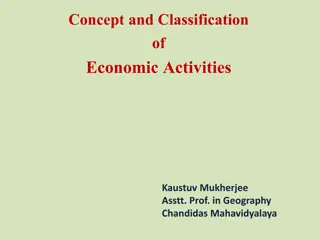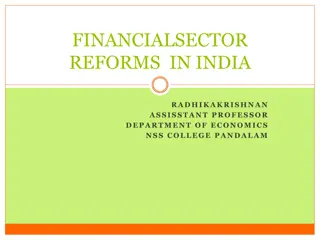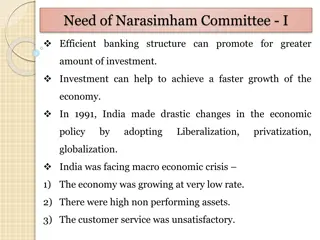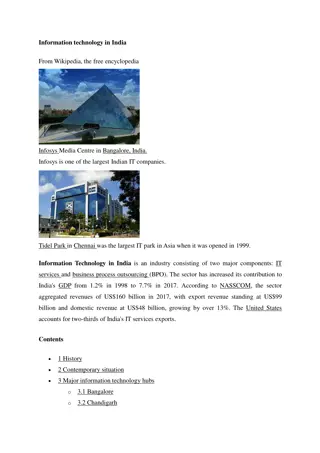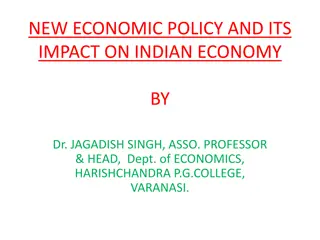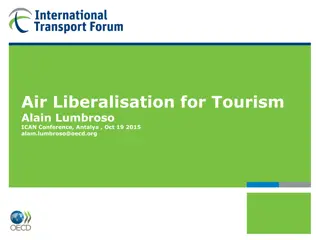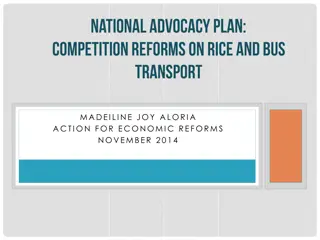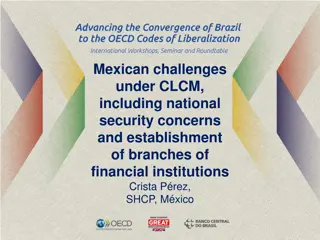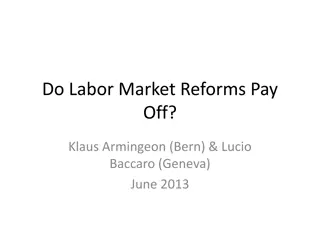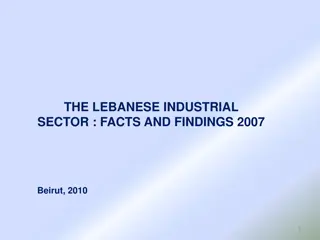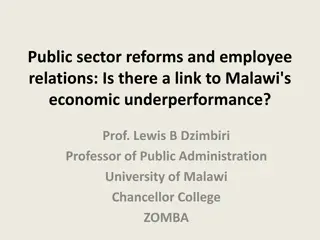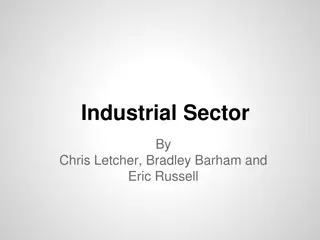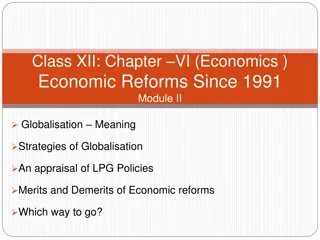Economic Reforms Since 1991: Liberalisation and Industrial Sector Reforms
Economic reforms initiated in 1991 under the New Economic Policy focused on liberalisation, privatisation, and globalisation to accelerate economic growth. Liberalisation involved deregulation of the industrial sector, abolishment of industrial licensing, reduction of public sector industries, de-reservation of production areas, and freedom to import capital goods.
Download Presentation

Please find below an Image/Link to download the presentation.
The content on the website is provided AS IS for your information and personal use only. It may not be sold, licensed, or shared on other websites without obtaining consent from the author.If you encounter any issues during the download, it is possible that the publisher has removed the file from their server.
You are allowed to download the files provided on this website for personal or commercial use, subject to the condition that they are used lawfully. All files are the property of their respective owners.
The content on the website is provided AS IS for your information and personal use only. It may not be sold, licensed, or shared on other websites without obtaining consent from the author.
E N D
Presentation Transcript
Class XII: Chapter VI (Economics ) Economic Reforms Since 1991 (Module-I) MEANING OF ECONOMIC REFORMS ELEMENTS OF NEW ECONOMIC POLICY ECONOMIC REFORMS UNDER LIBERALISATION 1.Industrial Sector Reforms 2. Financial Sector Reforms 3.Fiscal Reforms 4. External Sector Reforms PRIVATISATION
MEANING OF ECONOMIC REFORMS Economic reforms refer to a set of economic policies directed to accelerate the pace of growth and development . In 1991, the Government of India initiated a series of economic reforms to pull the economy out of the crises of 90 s. These reforms came to be known as New Economic Policy(NEP). ELEMENTS OF NEP (NEW ECONOMIC POLICY) Liberalisation, Privatisation and Globalisation are the three main elements of NEP.
LIBERALISATION : Liberalisation of the Economy means freedom of the producing units from direct or physical controls imposed by the government. Prior to 1991 Government has imposed several types of controls on private enterprises in the domestic economy. These included industrial licensing system, price control or financial control on goods, import licence, foreign exchange control, restrictions on investment by big business houses, etc. It was experienced by the government that several shortcomings had emerged in the economy on account of these controls. These controls had given rise to corruption, undue delays and inefficiency. Growth rate of GDP had fallen sharply and high cost economic system (rather than a low cost competitive economic system) came into being. In view of these facts, Liberalisation of the economy was considered as a key component of NEP. Greater reliance was to be placed on market forces (of supply and demand) rather than checks and controls. i. ii. iii. iv.
ECONOMIC REFORMS UNDER LIBERALISATION Liberalisation include the following reforms INDUSTRIAL SECTOR REFORMS: Liberalisation virtually implied de-regulation of industrial sector of the economy. Abolotion of industrial licencing: In July 1991, a new industrial policy was announced .It aboloshed the requirement of licencing except for the following five industries. ( a) liquor (b) cigarette (c) defence equipments (d)industrial explosives (e) Dangerous chemicals. Contraction of Public sector: Under the new industrial policy, number of industries reserved for public sector was reduced from 17 to 8. In 2010-11, the number of these industries was reduced merely to two: i. Atomic Energy and ii. Railways. i. ii.
iii.De-reservation of Production Areas: Many production areas which earlier were reserved for SSI (Small Scale Industries) were de-reserved. Forces of the market were allowed to determine allocation of resources (rather than the directive policy of government). iv. Expansion of Production Capacity: Earlier production capacity was linked with licencing.Now, freedom from licensing implied freedom from capacity constraints. What to produce and how much to produce was now matter of producer s choice depending on market conditions. v. Freedom to Import Capital Goods: Liberalisation also implied freedom for the industrialists to import capital goods with a view to upgrading their Technology. Permission was no longer required from the government to enter into international agreements for the import of technology.
FINANCIAL SECTOR REFORMS: Financial sector includes : (i) banking and non-banking financial institutions, (ii) Stock exchange market and (iii) Foreign exchange market. In India, financial sector is regulated and controlled by the RBI (Reserve Bank of India). Liberalisation implied a substantial shift in the role of the RBI from a regulator to a facilitator of the financial sector. Free play of the market forces has led to the emergence of private bankers- both domestic as well as international in the Indian banking Industry. Liberalisation also allowed FII (Foreign Institutional Investors) to invest in Indian financial markets . Examples of FII: Merchant bankers , mutual funds and pension funds. Consequent upon these changes, financial sector in India has shown a multi dimensional growth and is playing a significant role in the growth and development of the economy.
FISCAL REFORMS: Fiscal reforms relate to revenue and expenditure of the government. Tax reforms are the principal component of fiscal reforms.Broadly, Taxes are classified as: a) Direct Taxes b) Indirect taxes Direct taxes are those taxes ,the burden of which can not be shifted to others Example: Income tax Indirect taxes are those taxes which can be shifted to others. Example: GST(Goods and Services Tax) Prior to liberalisation, tax structure in the country has been highly complex and evasive. Now tax structure has been simplified and moderated under fiscal reforms.
EXTERNAL SECTOR REFORMS: External sector reforms include: 1. Foreign exchange reforms and 2. Foreign trade policy reforms Foreign exchange reforms were initiated in 1991 with devaluation of the Indian currency against foreign currencies. Devaluation implies lowering the value of our currency in relation to other foreign currencies. This Devaluation increased the supply of foreign currency into the Indian economy by way of higher exports of the domestic goods and services. Foreign Trade Policy underwent a substantial change in the wake of liberalisation. Tariff restrictions have been moderated and competition replaced protection of industries.
PRIVATISATION: Privatisation is the process of involving the private sector in the ownership or operation of state owned enterprise. It implies gradual withdrawal of government ownership / managements from the public sector enterprises. It may happen in two ways 1. Out right sale of the government enterprises to the private entrepreneurs or 2. Withdrawal of the government ownership and managements from the mixed enterprises.




